©Copyright 2018 GEOSCIENCE RESEARCH INSTITUTE
11060 Campus Street • Loma Linda, California 92350 • 909-558-4548

DINOSAUR TRACKS AND GIANT MEN
by
Berney Neufeld
Department of Biology
Middle East College,
Beirut, Lebanon
Related page — |REACTION|
Reports of the presence of man in the lower parts of the geological column have been both intriguing and dubious. Read on....
WHY?
In the 1930's Dr. Roland T. Bird, a paleontologist from the American Museum of Natural History in New York, was collecting fossils in the southwestern United States [1]. It was near the end of a rather unproductive season, winter was coming on, and it was time for him to return to the museum. But, walking by a store in Gallup, New Mexico, he saw a sight that left him "a great deal more than startled," for there in the window were two tracks in stone. "On the surface of each was splayed the near-likeness of a human foot, perfect in every detail. But each imprint was 15 inches long!" [1]. Inquiry revealed that dinosaur-like tracks were also available, and that both varieties of tracks had come from the Glen Rose region of central Texas.
Dr. Bird traveled to Texas and found dinosaur prints by the score exposed in the bed of the Paluxy River. He uncovered many additional tracks and collected the best of these for the museum by breaking up the 12 to 16-inch thick sheet of limestone in which they were embedded. These trackways, in carefully numbered pieces, were hauled to New York City on flatcars and a portion of this material has been reassembled and is on display today in the dinosaur hall of the American Museum of Natural History.
Did Dr. Bird find any human-like tracks in Texas? Apparently not, or it seems that he would have reported them, for he drove a quarter of the way across the continent in search of such tracks [2]. In the years following Bird's excavations there have been many stories and rumors reporting giant human tracks found associated with the dinosaur tracks of the Paluxy River. According to the standard geological time scale, the last dinosaur died about 60 million years before man should have come on the scene. Large mammal tracks of any sort found in association with dinosaur tracks would be a valuable piece of data in the continuing development of theories of earth history. The persisting rumors of the existence of giant man-like tracks in various collections reported to have come from Texas led some of my colleagues and me to a decision to make a careful study of the evidence.
METHODS
Study Area
Paluxy River, north of Glen Rose, Somerville County, Texas. The riverbed was examined for 1-2 miles upriver and downriver from Dinosaur State Park. Some tributaries were also examined. Much of the detailed work was done on the McFall farm 2 miles upriver from the State Park.
Location of Tracks
As far as was determined, all the dinosaur tracks are in a single limestone layer 6-16 inches thick [3]. An examination of this limestone reveals it to be rich in plant fossils. The track layer lies beneath a few inches of blue-gray clay. Above the clay is another limestone layer.
Preparation of the Tracks for Study
The River carries a great deal of sediment, and tracks quickly become filled with mud. A stiff broom was used to brush sediment out of the tracks. Often it was necessary to sweep large areas of river bottom beneath a few inches of water to survey for possible tracks. Most of the tracks are below water level, and dikes were built around them for detailed study.
Study of Tracks
Photographs were taken of tracks from different light angles and perspectives. Tracks in series were photographed in toto and individually, and plaster of Paris casts were made of the interesting ones.
There are a number of dinosaur and mammal-like tracks owned by individuals and organizations (see Figures 1-4).These tracks were cross-sectioned with a diamond rock saw to determine whether they were made by feet or by hand. If a track was made by a foot the compression of the layers within the mud should conform to the track when viewed in cross-section. If the track was carved from hardened rock, then a cross-section should show the layers of the rock ending abruptly at the edge of the track in a manner analogous to a stream-channel cut through layers of sedimentary rock.
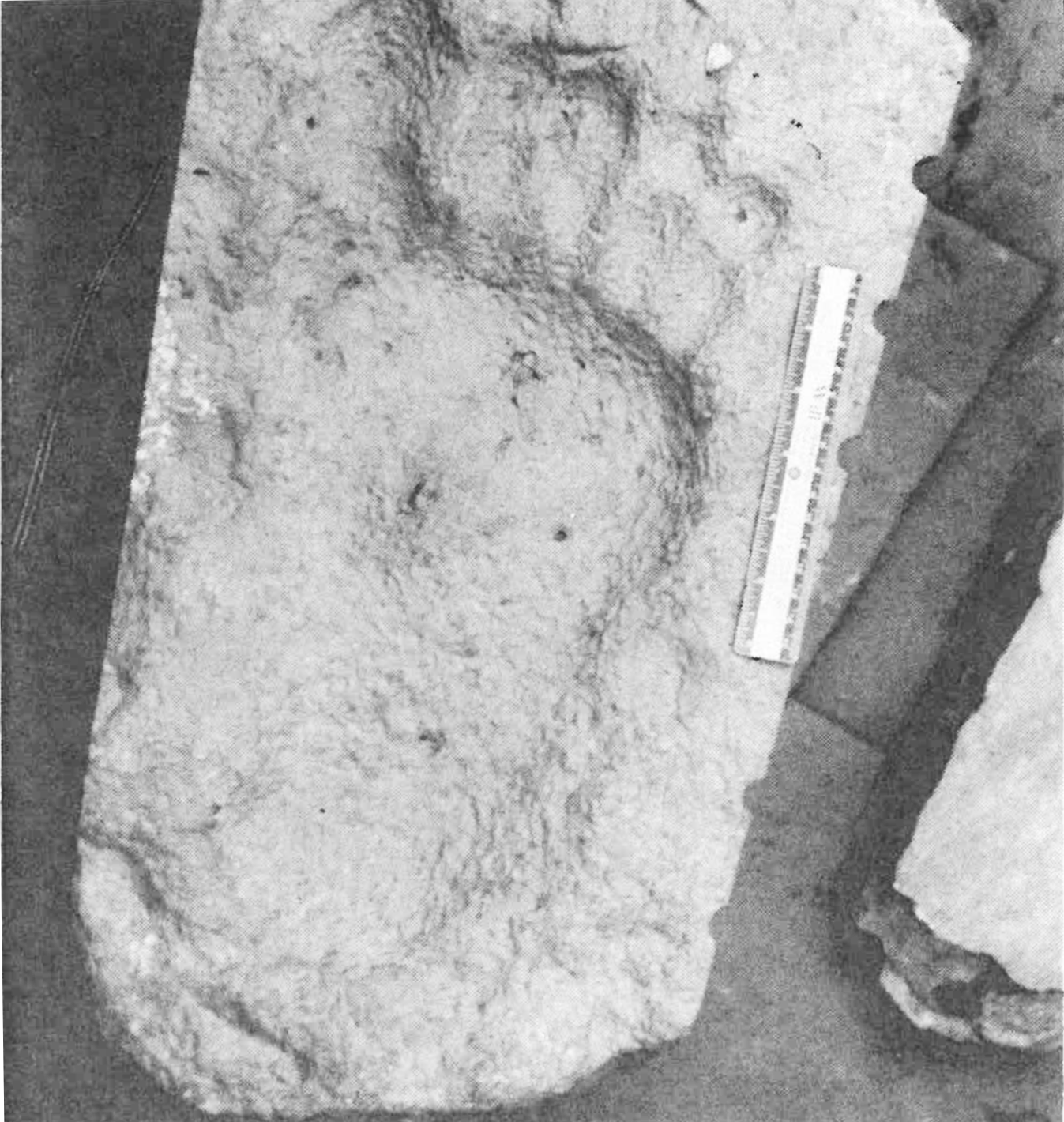
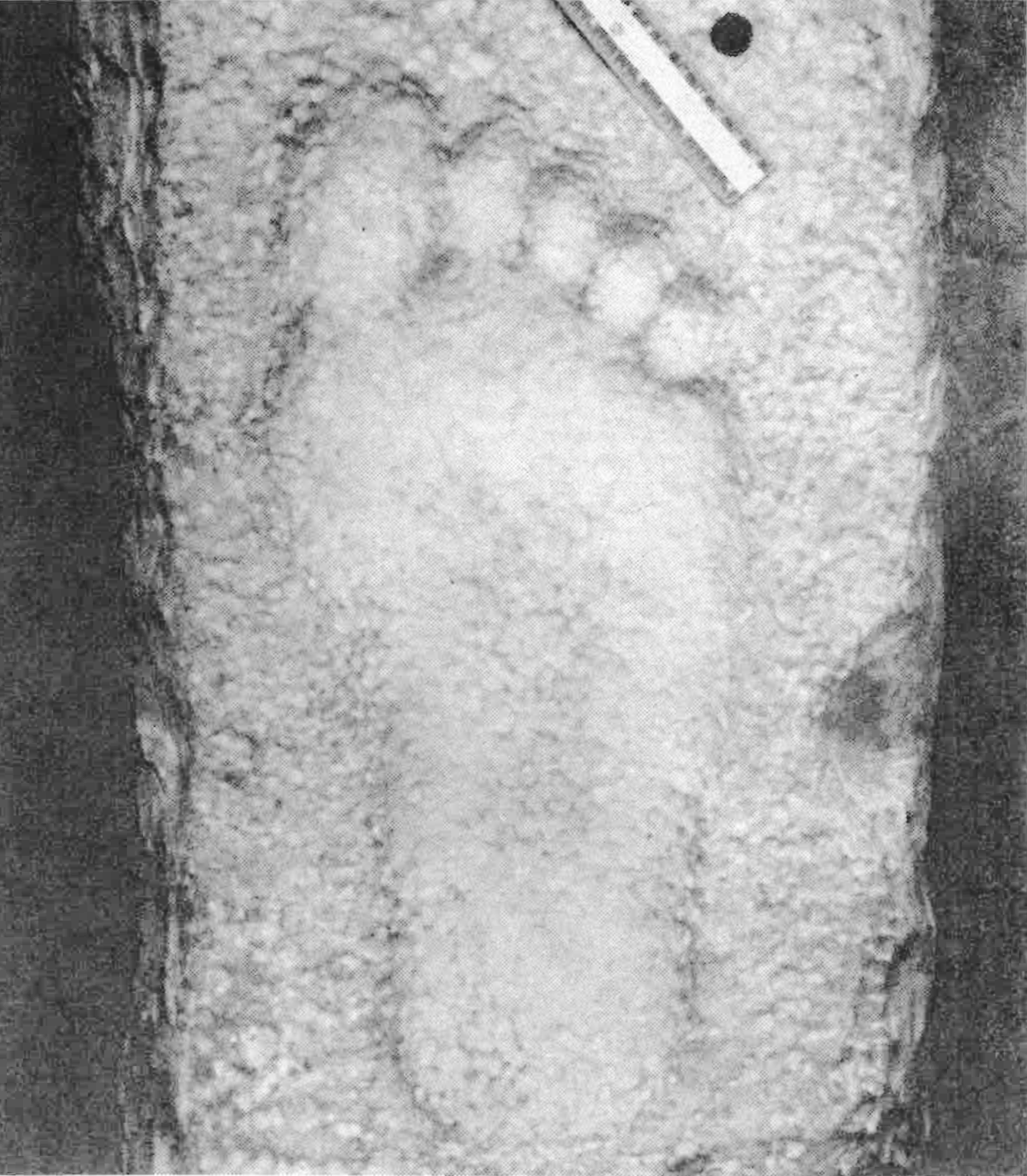
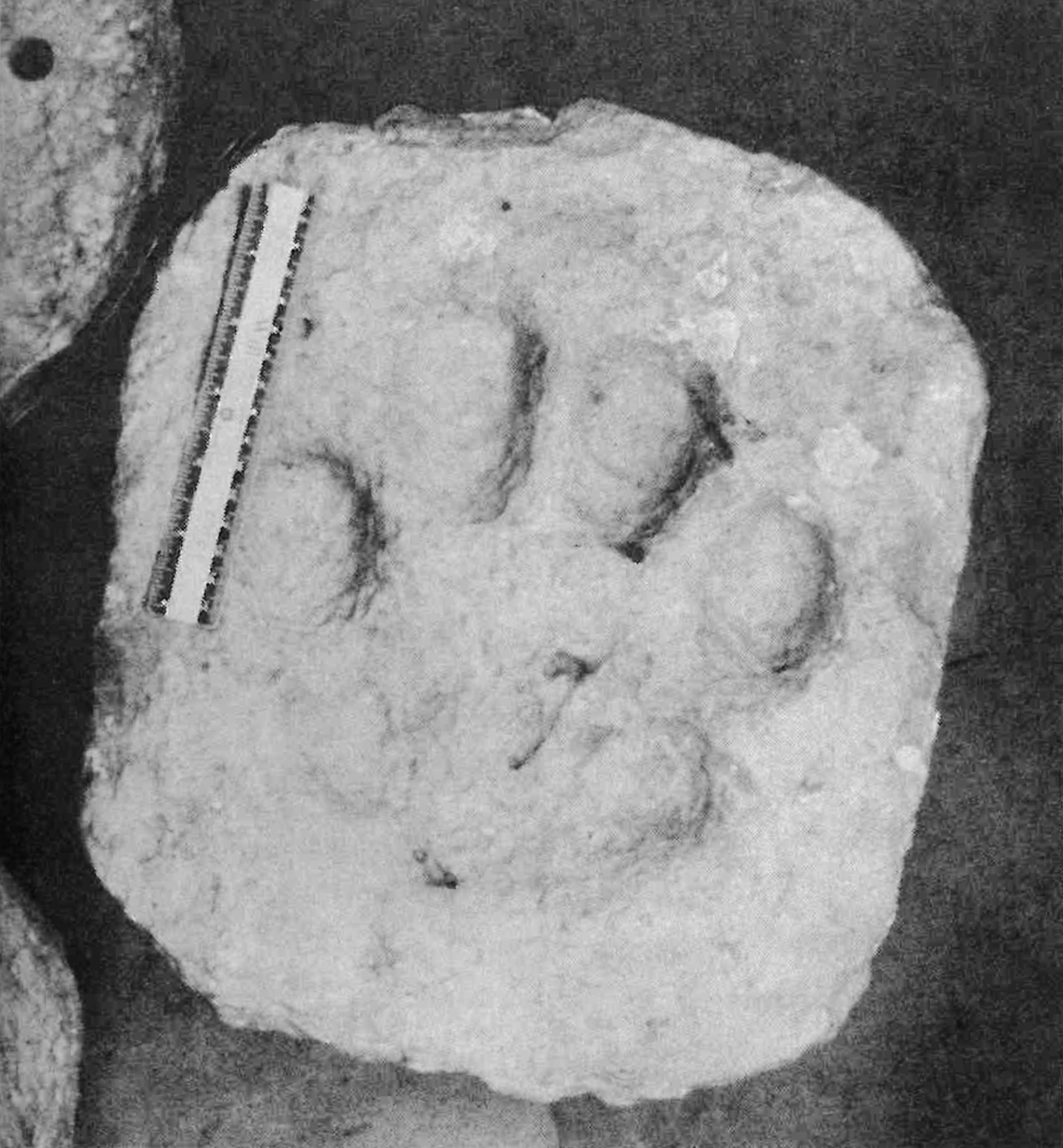
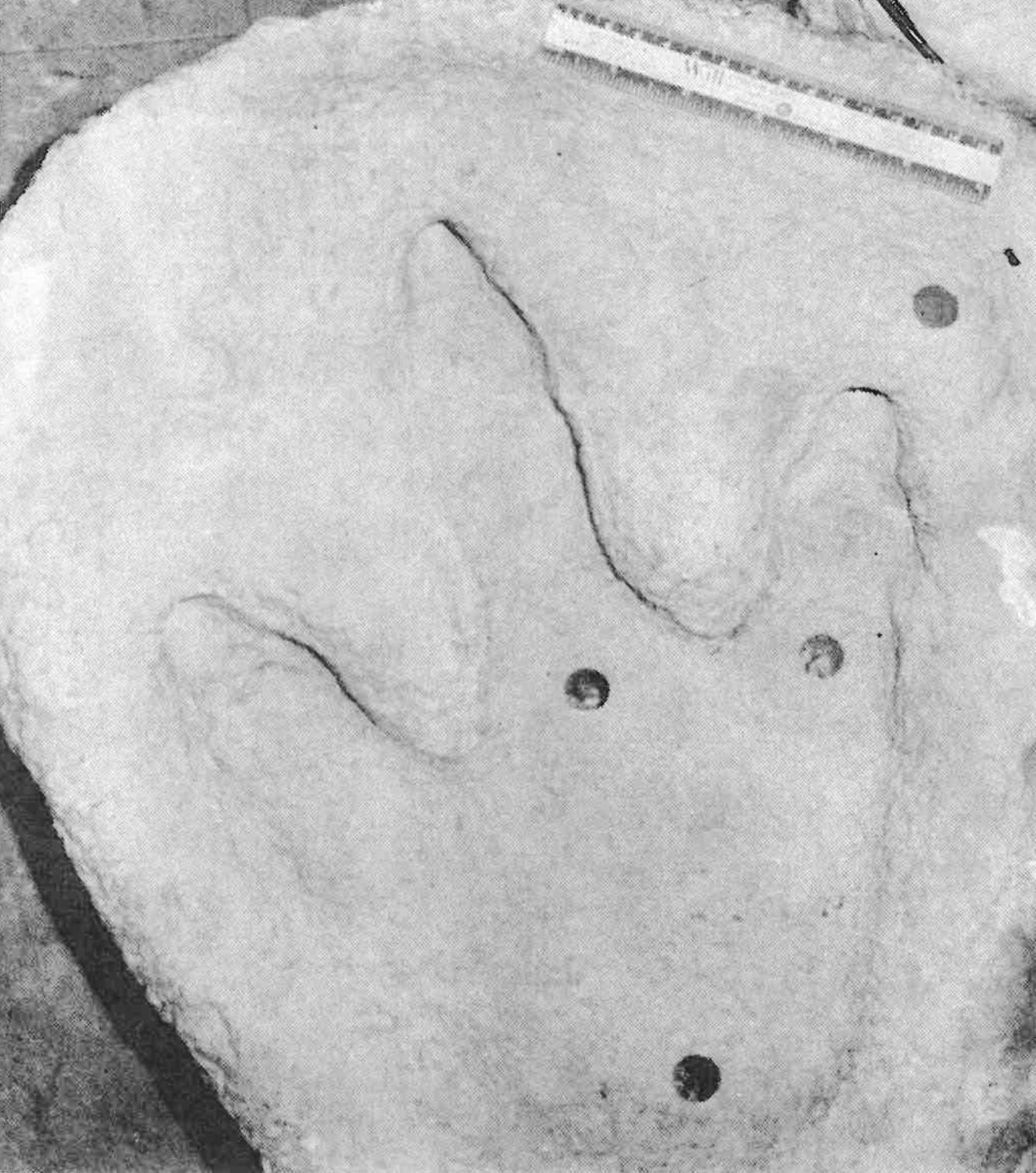
RESULTS AND DISCUSSION
Tracks in situ
Aptosaurus (Brontosaurous, the "Sinclair dinosaur," Figure 5). These tracks were rare in the area studied. Up to 3 feet in diameter and 18 inches deep, with the claw marks plainly visible, they are exciting, to say the least.
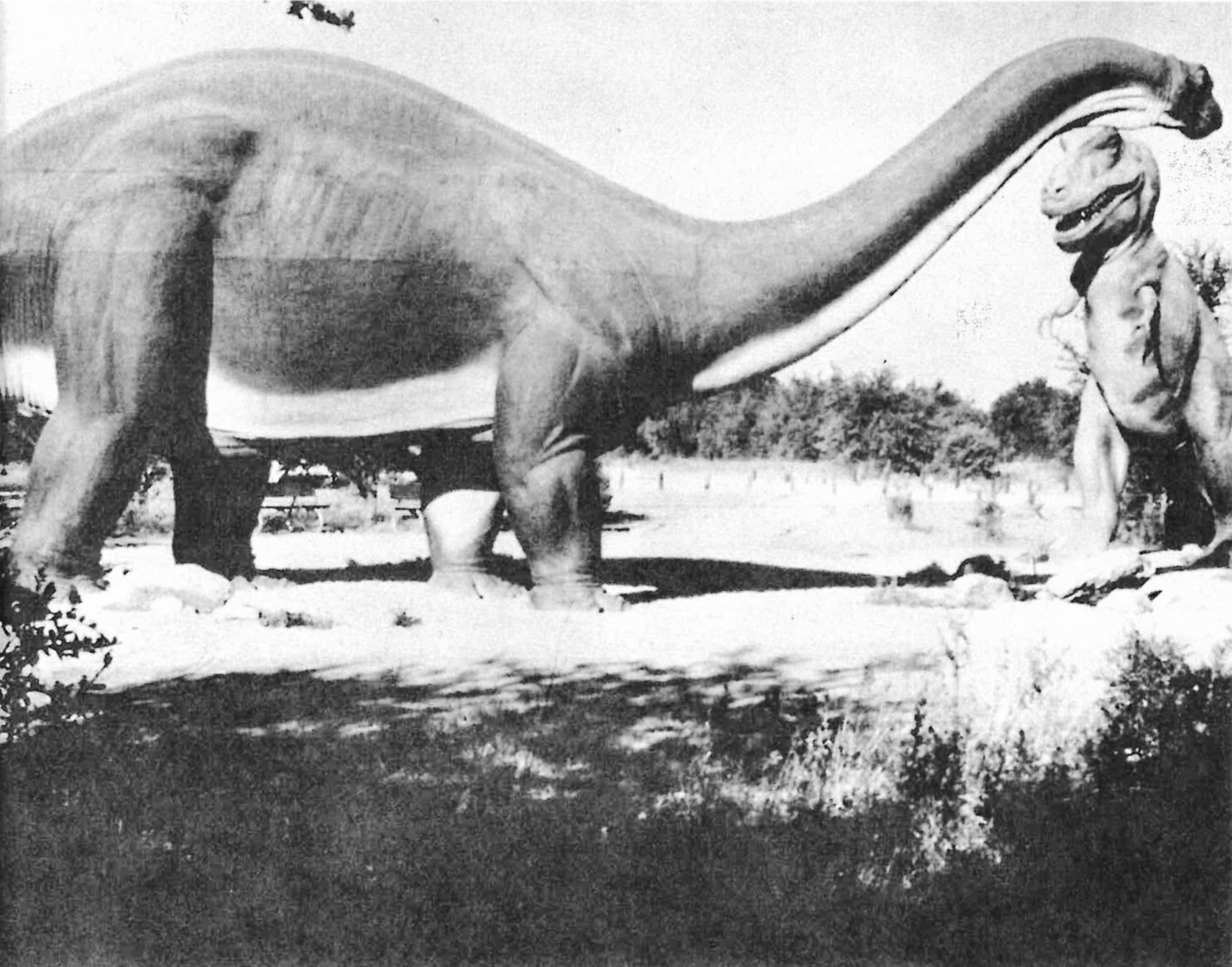
Three-toed Tracks
(Allosaurous, Figure 5). Most of the dinosaur tracks observed fell into this category. Their distinctive bird-track-like shape makes them detectable even when badly eroded. One trackway could be followed for over 100 yards along the river bottom. A new trackway of this type was partially uncovered in which the tracks were 18-24 inches long and up to 10 inches deep (Figure 6).
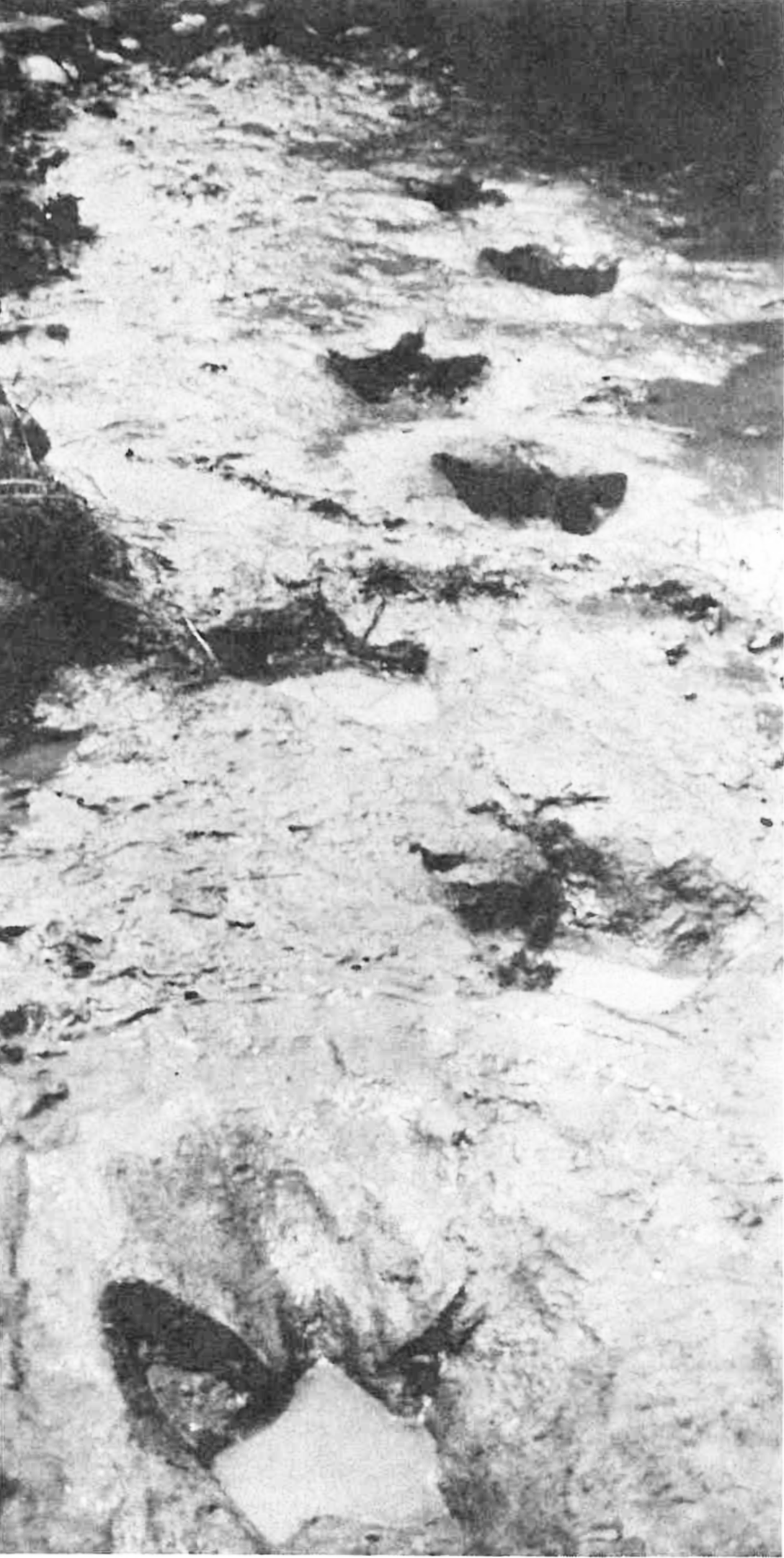
Elongate Tracks
Several series of this sort have been discovered. The tracks are approximately 18 inches long and 5-8 inches wide. There appears to be no question that some represent the passing of a biped. All present examples of these prints are badly eroded, and the details of the tracks are quite indistinct. Three of these trackways are discussed in detail below.
Series 1 (Figure 7): Located on the upriver side of the McFall farm, these tracks are on the south bank of the river several feet above the river bottom. The imprints are 2-6 inches deep, and the trackway is visible for a dozen tracks or so. At the downriver end the prints disappear where the bank has been eroded away beneath them; on the other end they turn under the overlying bank. This overlayer has been dug away for several feet and two additional tracks have been uncovered. These tracks have been interpreted by some to be giant human tracks headed upriver. Examination of the downriver end of the tracks (toward the lower edge of Figure 7) reveals that several of them show the print of a three-toed dinosaur. It is not clear how the prints acquired their elongated shape, but it is obvious that the tracks cannot be both man and dinosaur.
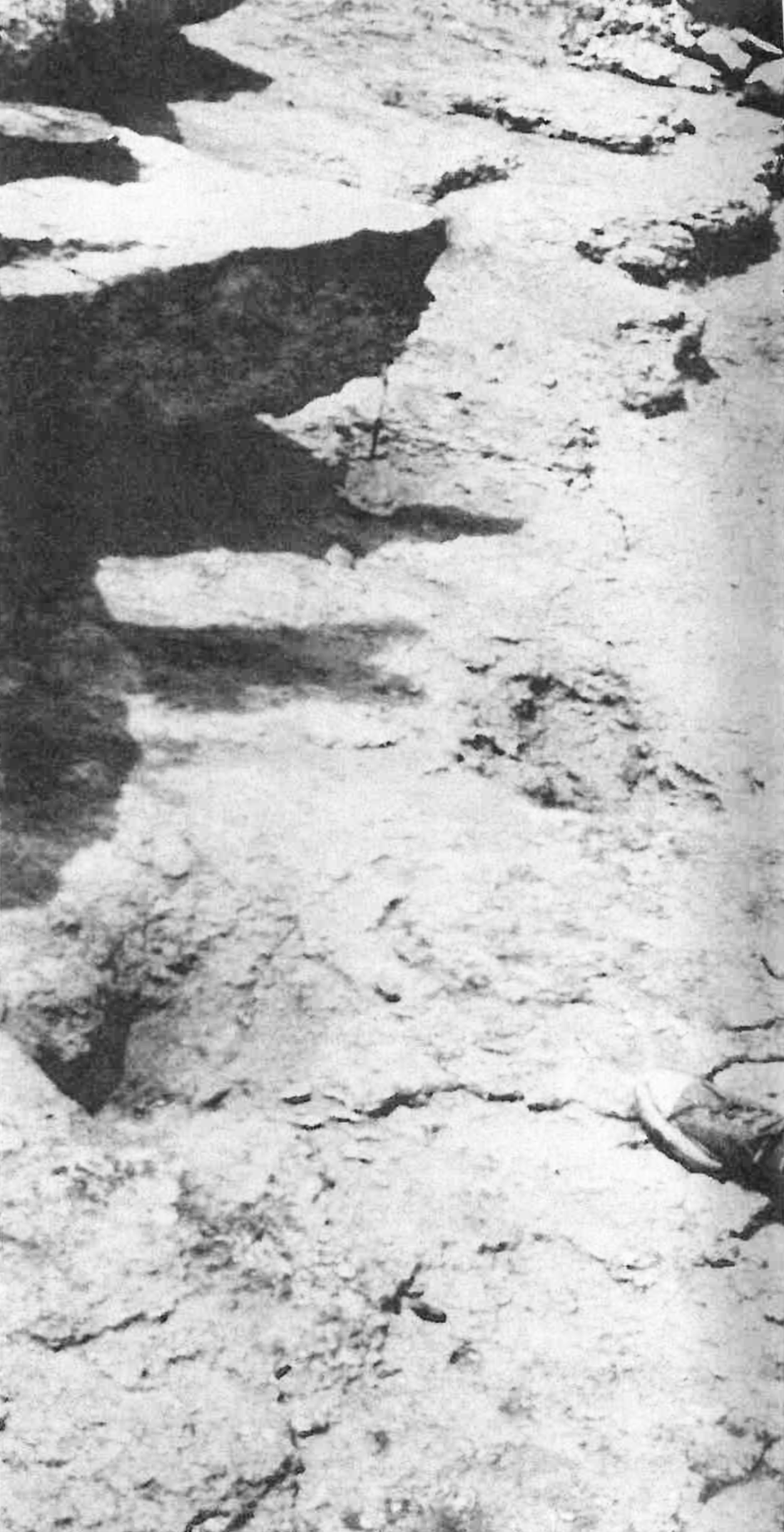
Series 2 (Figure 8): This series is located at the downriver end of the McFall farm and has been studied by several groups in the past. The tracks are under water and are very shallow, running parallel to the river along the north bank. On the downriver end, they turn towards the river and are lost due to erosion. Apparently the same occurs upriver. The tracks are ½-1 inch deep, and their general form can be described as moccasin prints. Casts were made of the entire series. Comparison of these to the Series 1 elongate tracks has led to the conclusion that at least two members of the series are badly eroded dinosaur tracks. The upriver ends of these prints appear to be divided into the typical three-toed pattern.
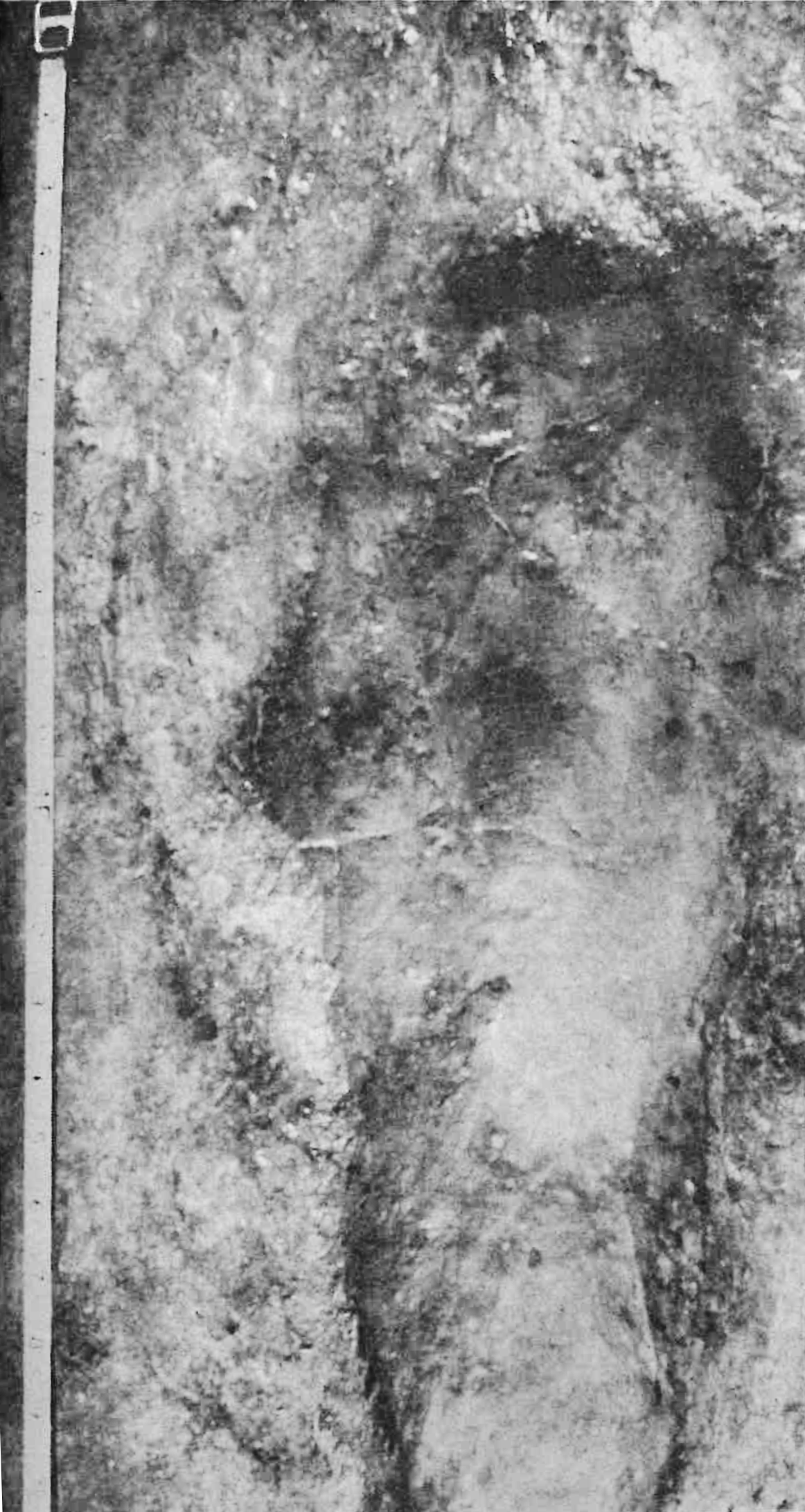
A few feet downriver from these is the three-toed dinosaur trackway discussed above (Figure 6). These tracks are in a beautiful state of preservation. It appears that if these tracks were eroded down to the shallowness of the elongated track series nearby, they would look much like the shallow tracks of the nearby series. If any track in a series is from a dinosaur, it must be assumed that the entire series was made by the same creature. The elongate tracks of Series 2 probably represent the last vestiges of a three-toed dinosaur trackway.
While it is difficult to demonstrate that these highly eroded tracks are reptilian, it is more difficult to show convincingly that they represent the passing of a hominid wearing soft-soled footwear. This track-containing layer is covered with bipedal dinosaur tracks. Except for the slight suggestion of a hominid form represented by this series, there is no verifiable evidence for the existence of bipedal man-like tracks in this layer. Were such evidence to exist, this series would at best be regarded as ambiguous data. In the absence of such other data, the most likely possibility is that these tracks are of reptilian origin.
Series 3 (Figure 9): These are probably the most famous "man" tracks of the Paluxy River [4]. They are located in the State Park area and are in the limestone layer that overlies the dinosaur track layer. This is significant because no dinosaur tracks have ever been found in this layer. The tracks are indistinct and badly eroded. They are about 12-15 inches in length, with 2 or 3 tracks possibly visible. Above water much of the year, they have been frequently examined. Often, in order to contrast the tracks with the surrounding rock for photographic purposes, they have been painted with oil. The tracks appear to have soaked up some of the oil and now contrast with the surrounding matrix even without treatment. In my opinion these footprints are not tracks at all, but represent random erosion marks in the surface of the limestone plate. The surrounding surface is covered with erosion marks of almost every imaginable shape. Individuals have reported visualizing the tracks of practically any mammal species on this surface. These "man" tracks have been observed for over a decade by Dr. Dexter Beary, chairman of the Biology Department of Southwestern Union College, Keene, Texas. He says that the big toe appears to be more distinct at the present time than when he first observed the "footprint" about 15 years ago (Figure 9). The print shown in Figure 9 is by far the best of the series. It is only with a great deal of imagination that a bipedal trackway can be seen at all.
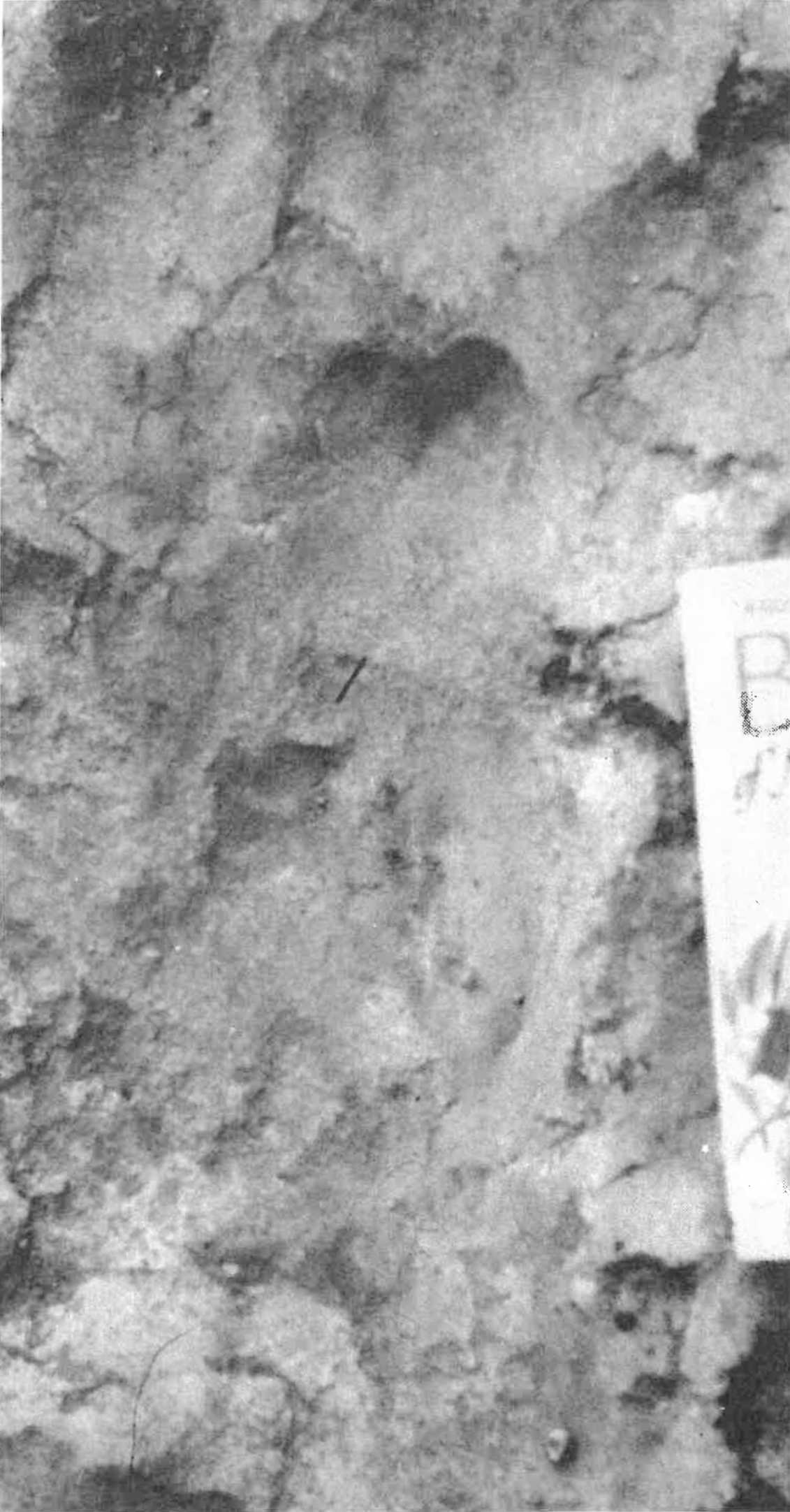
Holes in the Riverbed. There are several places in the river bottom where large pieces (2-3 feet in diameter) of the track-containing rock has been removed. Local residents say these holes are where tracks have been taken from the riverbed. Examination of the holes makes it clear that limestone blocks have been removed from these sites in the past. Some of the holes they recall as the source of human-like tracks. However, tracks in situ are of much greater value than samples whose origins are not well authenticated.
Tracks in the Laboratory
Dinosaur Tracks, Loma Linda University. A rather eroded three-toed dinosaur track was purchased from Mr. McFall which his son had "recently" removed from the Paluxy River. It has been sectioned and the compression of the limestone substrata is clearly evident (Figure 10). The bending of the "mud" layers to conform with the track shape is exactly what would be expected when a print was formed by a foot stepping onto soft layered material. The layers deeper in the mud remain undisturbed.
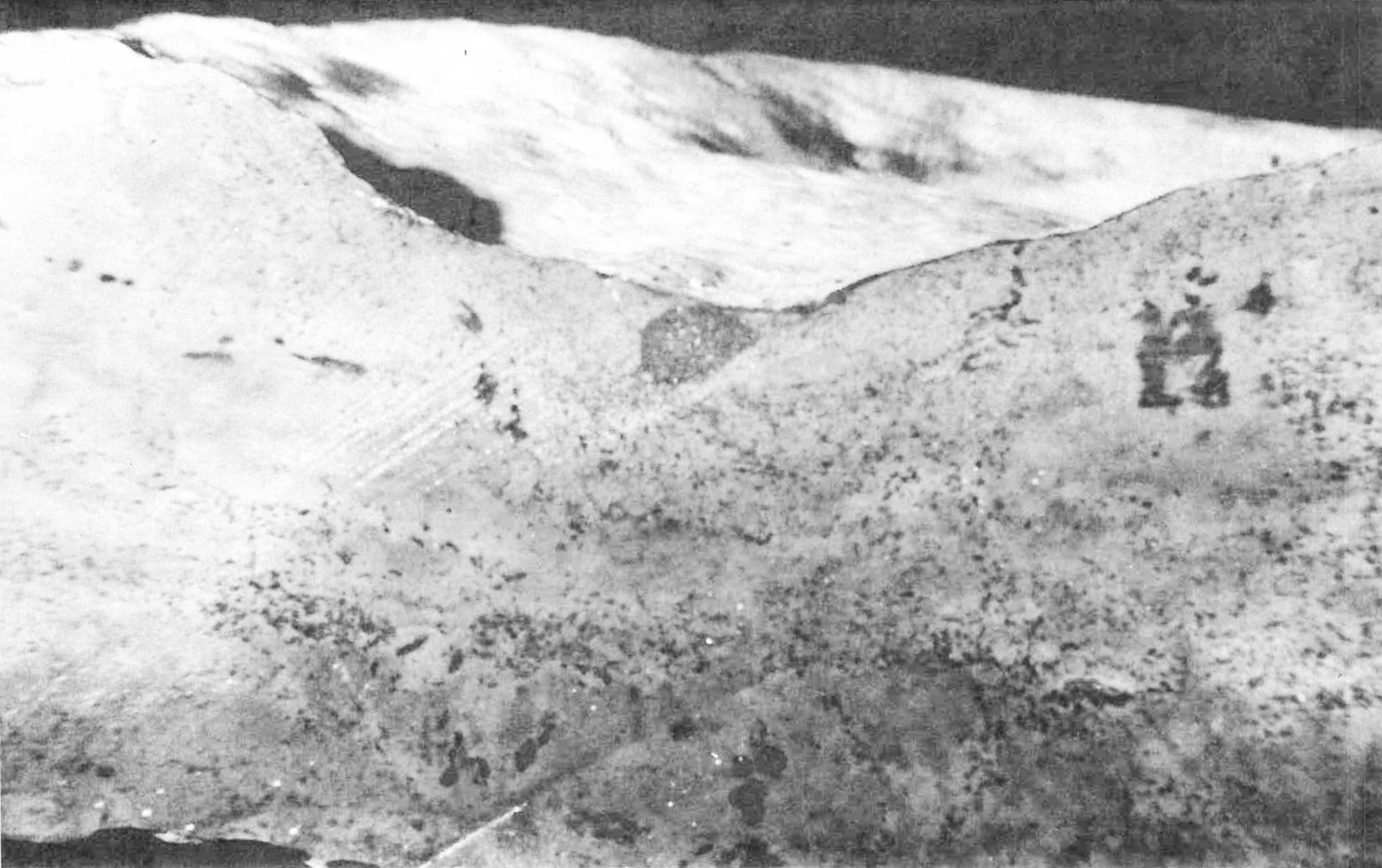
Tracks at Columbia Union College. Dr. Don Jones of Columbia Union College, Takoma Park, Maryland, has a number of tracks whose origin is reported as the Paluxy River. The collection includes a right and left human footprint, a pair of three-toed dinosaur tracks, and a large cat print (Figures 1, 3, 4). All of these, in separate blocks, appear to be in the same type of limestone. They also have a single human track of inferior quality that is in a limestone of a different color and texture from that of their other prints (Figure 2). One of the three-toed dinosaur tracks and both types of man prints have been cross-sectioned. In each instance the rock layers end abruptly at the edge of the track, indicating that they are not the result of a foot stepping into soft mud but are produced by carving (Figures 11, 12).
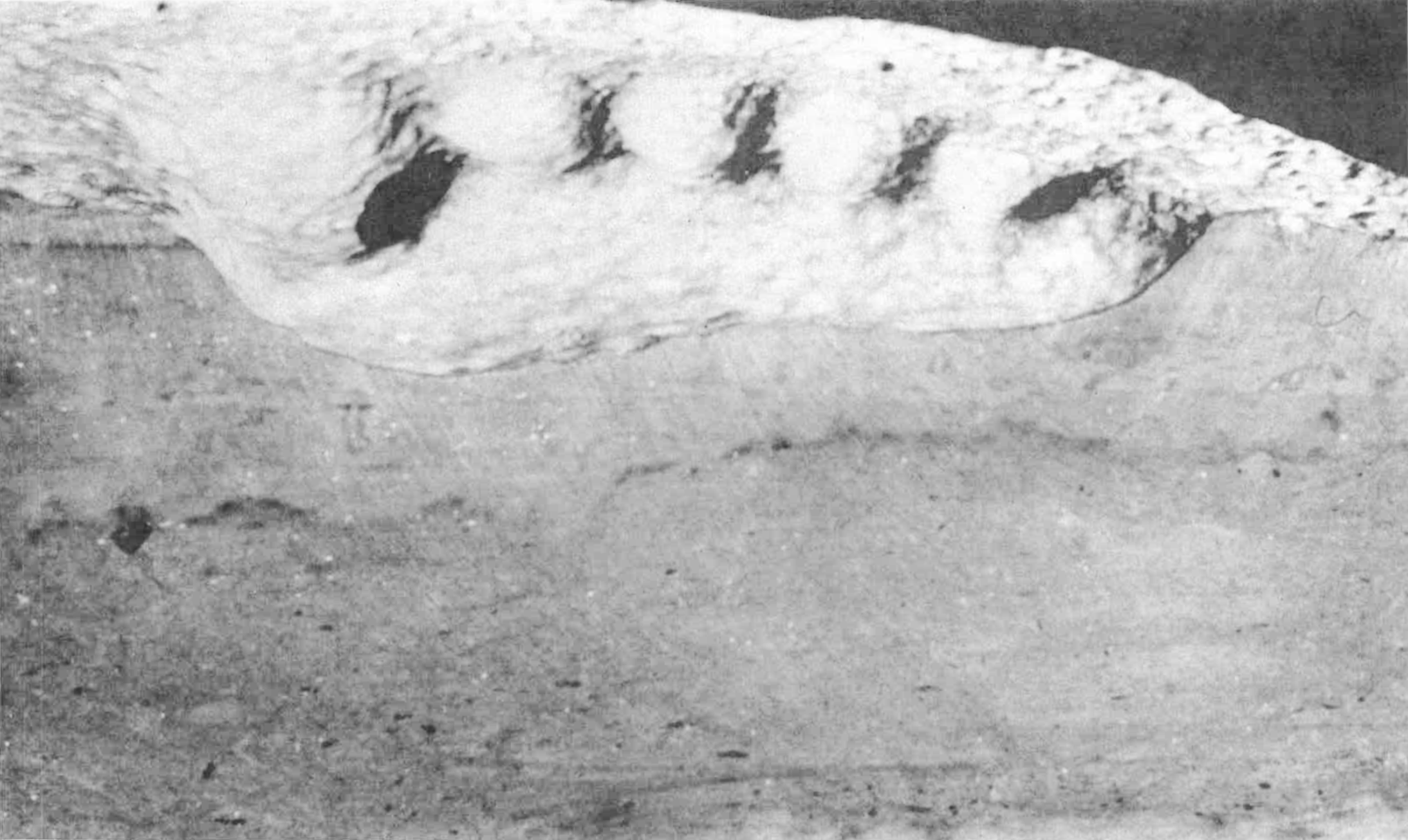
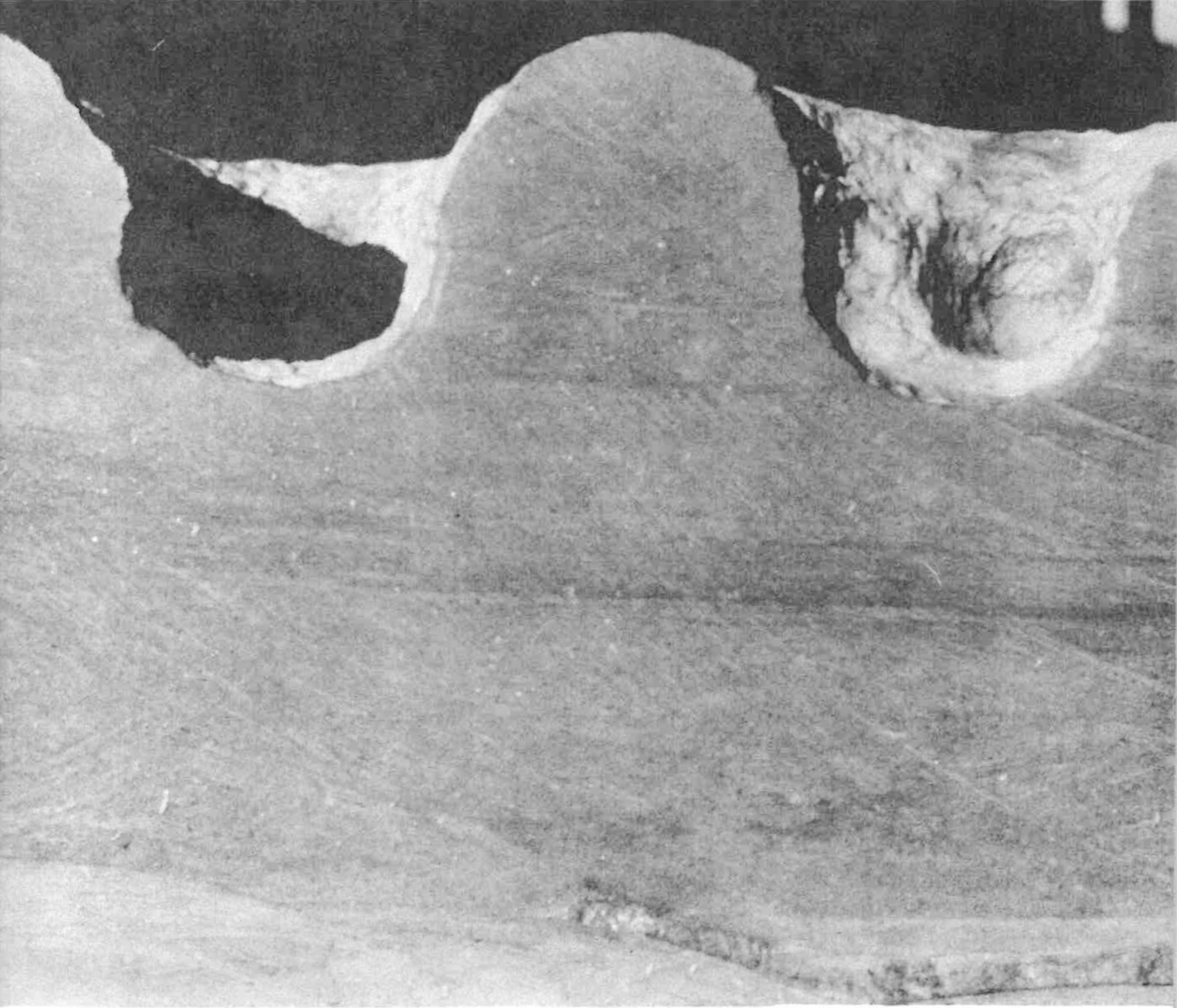
Clifford Burdick, a consulting geologist from Tucson, Arizona, has a man-like track and a cat-like track. Both have been sectioned, and the evidence is equivocal. Some cross-sections give a slight indication of carving, others of conformation. The difficulty with these tracks is that they are in blocks of limestone whose pattern is more mottled than layered.
Local old-timers in the Paluxy River area tell that tracks were both excavated and carved as a source of income during the depression years. Both of these collections may well be carvings from that period.
Other Tracks. There are numerous stories claiming that other tracks exist or have existed in the past. I have been unable to locate any of these tracks and feel that if they do exist, they should be cross-sectioned to determine their validity. If genuine mammal tracks are found, it will still be necessary to determine where they came from. The limestones in the area studied are distinctive, and should be identifiable by their mineral and fossil compositions.
CONCLUSION
The Glen Rose region of the Paluxy River does not provide good evidence for the past existence of giant men. Nor does it provide evidence for the co-existence of such man (or other large mammals) and the giant dinosaurs. It seems likely in retrospect that the rumors of giant-man tracks had their origin in the discovery of tracks similar to the elongate tracks of Series 2.
Does this mean the concept of antediluvian man and the flood story is incorrect? No. It may be only evidence that those men at that time did not cohabitate with dinosaurs. "To ignore all such reports, because they are sometimes inaccurate would be like refusing to listen to the weather forecast because the predictions sometimes fail to materialize. To accept all such reports as factual would be like believing without verification all the claims made by an automobile dealer or a real estate salesman" [5]. In any kind of investigation, but especially when investigating the past where data is more equivocal, caution and thoroughness should characterize the work done, and conclusions should not be drawn prematurely [6].
ACKNOWLEDGMENTS
I would like to acknowledge the help of my co-workers of the Department of Biology at Loma Linda University: Drs. Arthur Chadwick and Leonard Brand, and Walter Cox, a graduate student, the help of Dr. Dexter Beary of Southwestern Union College, and Dr. Don Jones of Columbia Union College. They have done a great deal of the actual work reported here. The interpretation of the evidence is my own. My thanks also to Dr. Gwynne Neufeld for aid in the preparation of this manuscript.
REFERENCES AND NOTES
[1]Bird, Roland T. 1939. Thunder in his footsteps. Natural History 43(5):255.
[2]What Dr. Bird actually saw can, at this point, only be known to him. Through the auspices of Dr. Eugene S. Gaffney, Assistant Curator of the American Museum of Natural History, I have attempted to locate the field notes made by Dr. Bird in Glen Rose. They are not on file at the Museum in New York City. Dr. Gaffney asked Dr. Bird (retired in Florida) for his notes; however these were not found.
[3]We found no exceptions to this statement, but we did not follow, continuously, the various layers along the several miles covered by this survey.
[4]Taylor, Stanley E. 1971. The mystery tracks in dinosaur valley. Bible-Science Newsletter 9(4):1-3, 6-7. Films for Christ Assn. (R.R. 2, Eden Road, Elmwood, IL 61529) has released a film entitled "Footprints in Stone" based on this work. Our conclusions differ from theirs.
[5]Ritland, Richard M. 1970. A search for meaning in nature. Pacific Press Publishing Assn., Mountain View, California, p. 232.
[6]Additional references: Bird, Roland T. 1954. We captured a 'live' brontosaur. National Geographic, May 1954, pp. 707-722; Cook, Neal. 1969. Dinosaur tracks. Texas Parks and Wildlife 27:3-5; Ingalls, Albert G. 1940. The carboniferous mystery. Scientific American 162(1):14.